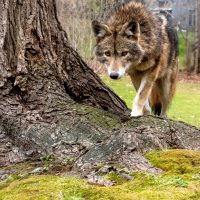Lexington Student Wins NatGeo Award
SOREN GOLDSMITH USES PHOTOGRAPHY FOR ENVIRONMENTAL EDUCATION AND ACTIVISM
 Trying to photograph a coyote at 2 a.m. in Lexington center can be a tricky ordeal. That’s what Soren Goldsmith was trying to do a few years ago one early freezing winter morning.
Trying to photograph a coyote at 2 a.m. in Lexington center can be a tricky ordeal. That’s what Soren Goldsmith was trying to do a few years ago one early freezing winter morning.
It was one of Goldsmith’s first endeavors in wildlife photography, and he was determined to try to capture the typically shy and elusive predator. Not surprising, the police showed up, asking why he was standing on the side of the road at this ungodly hour. Fortunately the recent high school graduate had his Nikon camera with him as proof that he wasn’t crazy – he was just trying to take photos to help reveal the unseen wildlife all around, even in suburbia.
Goldsmith did end up getting a photo of a coyote under the streetlamp, and this cool silhouette shot against the buildings and sidewalks helped propel his desire to create photos that connect viewers to conservation and the environment around us. “I use photography as a tool for education to ensure that future generations get to coexist with the same nature we live among today,” said Goldsmith, a Follen Hill resident who loves to explore nearby Dunback Meadow, a meadow and pine forest which acts as a pathway for wildlife through the community.

Some of Goldsmith’s friends look at his Instagram feed of owls, fisher cats, nuthatch, and more, and say incredulously, “Dude, where do you find these?” His reply, “Just look, they’re right next to you.”
Goldsmith does just look – and look, and look, and look. His coyote encounter and others led him to apply for a Mass Audubon grant with which he purchased two expensive motion activated cameras. He placed them in conservation lands and became enthralled with the images he captured. It wasn’t easy though – knowing how to position the cameras can be tricky; photos can be blurry, and even a branch swaying on a windy day can set off the motion trigger. He hiked through muddy trails, avoiding tick-ridden brush, to swap out batteries, recharge and put new ones in, The cameras take thousands of photos, including frequent misfires, often with only one viable picture, if that. If Goldsmith was lucky, he’d get one good photo every two weeks, putting in 10-15 hours of work for one picture. “To even know where to position the camera, you need to look for game trails, animal footprints and paths of least resistance through the woods,” said Goldsmith.
Goldsmith began using his wildlife photography to help conservationists attempt to stop Belmont Hill School from deforesting seven acres of woodlands – upstream from wetlands and home to hundreds of wildlife – to build a 150 car parking lot. That’s when he heard about the National Geographic Slingshot Challenge, a competition that challenges youth to create a one-minute video depicting a solution to the planet’s environmental problems. It’s called slingshot because it’s about sharing ideas for slingshotting the planet forward. Goldsmith thought, “Wow, this fits so well with what I’m doing. I have a really good story to tell here.” He wrote up the script and filmed footage panning the camera traps, included a bunch of photos, and recorded himself talking – “the hardest part” and sent in his submission. Five winners were to be chosen out of more than 1,800 submissions from across 80 countries.
Goldsmith had just rolled out of bed and checked his phone one morning in May when he saw the email notification that his video, “Save the Forests” had won, along with youth from Mexico (addressing climate change by rehabilitating ecosystems affected by forest fires); Pakistan (cleaning the air through a community-driven cycle club), Nigeria (Protecting nature through community education to prevent poaching and logging) and California (using the power of social media to connect local waste reducers.) “The idea that I would actually win seemed so far fetched,” he said. “I was in a state of shock for the whole day.”
Goldsmith has just returned from the National Geographic Explorer’s Festival in Washington D.C., where he met the National Geographic Explorers, exceptional individuals who receive funding from the Society to protect our world through work in science, exploration, education, and storytelling. The highlight was meeting Joel Sartore, a world famous wildlife photographer and conservationist – and Goldsmith just found out he was mentioned in the July issue of National Geographic magazine.
Goldsmith is off to the University of Wisconsin-Madison to pursue a degree in environmental engineering in the fall, but in the meantime, he’s hoping that his photography work helps people to care about the urban wildlife around them. “It’s true that we don’t live in the Amazon rainforest, but there is still a lot of biodiversity all around us.”
And what is his personal favorite wildlife photo? It’s a photo of a coyote, taken in the Belmont Hill forest. You can see the beautiful brown fur coat and amber colored eyes, and in the background is the forest – but you can also see a house. It’s a reminder that animals live among us, and people and animals are interconnected. “I want to help save the forests. The challenge is getting other people to care.”
